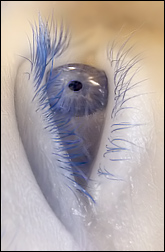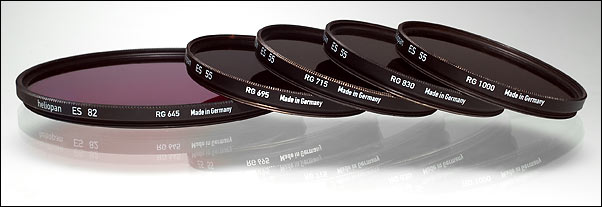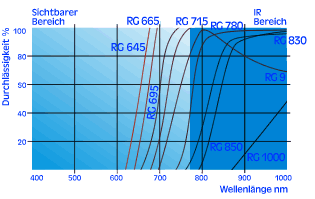
Chapter 1

Open your eyes, now close them - and see different.
Now we know that we are
only able to visually decode so much of the waveferno around us - and surely
not for the worst ;-)
Mentioning infrared photography most commonly brings the enthusiastic layman
to respond with "Ahh, capturing heat signatures!" along with conspiratorial
lifted eyebrows. First work to do there is to set this right where we stumble
over one important differentiation - the whole infrared band usually gets divided
into 3 scientific different ranges, for our purposes we only need two. The first
range from about 780nm to 1400nm is called the "near" infrared whilst
everything above is to be referred to as "far" infrared. Near means
close to our visible spectrum. The far infrared cannot be decoded with optical
means - sensors, usually cooled down to freezing ranges, need to be used to
do thermal imaging there.
We photographers, as big devotees to the glass we need to use, need only to
care about the near infrared then - and that´s exciting enough!
Basics about light and colors:
Light waves are being emitted
and hit objects on their course. Every object reflects or absorbs a certain
amount of them. Our built-in imager stands somewhere in space where reflected
rays can hit the photoreceptors. That´s the general setup. If an object
absorbs every incoming ray we get none ourselves from it - so we see "black"
as in nothing. There is no such thing as a perfect blackbody in our visible
spectrum, so an object is always bound to reflect something. If an objects reflects
as much as the entire spectrum we perceive it as white - the colors in between
are being the perception of partial reflectance of waves. The single channels
of our cone-based color system are put together by our brain to "show"
a color image.
Now if we would like to
perceive only one "color" or kind of wavelength - we need to get rid
of all the other waves. If we had a freely customizable"filter" where
we could easily set our starting and end wavelength the result would of course
be a completely monochrome image. Depending on the kind of imager used, an 8-bit
based system would record 256 different shades of luminance - zero being nothing
or black, 255 the highest as in white.
Based on this we can now take a look into the band between 780nm an 1200nm.
If there was a filter for the whole range here we´d get quite a dull image
- 420nm of information is quite much, too much obviously for 256 shades of tonal
difference. Good thing that the different available filters all have very narrow
windows to look into the near infrared.
Why filters?
Because we want to see what
we can´t see. To start with it will prove most interesting for us to cut
all wavelengths below 780nm. The real infrared experience can only be had this
way. There is infrared-photography as a quick effect to make the own pictures
more interesting - fast. Too bad you´ll lose some valuable food for thoughts
along this way. So i strongly recommend to buy one of the "deep" filters
as the first one - you´ll not regret it.
Filters

There is quite a bunch of
companies offering different filters, manufacturers of the glass they use seem
not as numerous though.
IR filters are offered by B+W, Cokin, Heliopan, Hoya and Kodak Wratten. Every
company (at least the professional ones) offers spectral charts for their filters,
this is needed to choose the own filter.
These are the spectral charts for Heliopan filters:

As we see, this company only produces 3, to be really exact 2 filters that fulfill our wish to completely block the visible spectrum.
Now what?
The unwanted waves are now
banned from reaching our imager, only "invisible" rays can pass -
we hold a small, deep black disc in our hand and wait for the narrator to go
on.
Many road are leading towards Rome, most of them with holes and dips for which
we now need a map.
Infrared photography can be achieved on 2 quite different imaging media - analog
film in all sizes and digital sensors.
Before reaching the crossroads where we say goodbye to film-based media and
concentrate on the digital world first some basic information.
The media of our choice
for recording has to be sensitive for the wavelengths we`d like to see.
To reproduce "natural" colors the best all manufacturers have found
that infrared "pollution" is unwanted and counterproductive - so on
every media there are different technical traps for this band.Your normal "fantastic
colors" film stops being sensitive before the near infrared band as well
as do most of the black and white films. You can screw on your filter and try
it - but next to nothing won't be much else to see for you on the resulting
picture.
The solution at hand is a few specialized films - a handful of black and white
films and one color film.The most famous of them would be Kodak´s HIE
(High speed Infrared Emulsion). Used for military aerial photography first and
then entering into civilian use now at least for this use quite obsolete because
there are enough high-tech laden satellites up there that do this job even better
and quicker. Good that fine art photographers and enthusiastic amateurs took
a liking of this technique so today stocks are still very wide available - but
still at a considerable premium. Ilford, Maco, Konica and some others offer
infrared-sensitive films today, the one looking into the band the deepest still
is the Kodak HIE which peaks out at about 1000nm.
The offering for color infrared never came to roll really fast - the Kodak EIR
could only convince a small crowd of photographers of it´s pictorial value.
The reason why infrared photography lives through a little renaissance these
days is a technical "flaw" in modern photo-cells out of which CCD
elements are comprised. With the very first digital cameras it seems to have
escaped the designers that the elements are well sensitive up to about 1200nm.
At this time no or very weak cut-filters were installed which led to "infrared-bleeding",
manifested in many pictures as "ugly" skin and red tones.
Until 2002 this still posed as a major problem for many manufacturers - it looks
as though a simple complete cutoff at 780nm was not enough and research was
slower than marketing demands. 2004 this is being handled very well - color
reproduction in general has never been better and infrared photography never
been that hard ;-)
The "system-cameras" most often got a little optical block inserted
into the ray-tube on which the Hot Mirror (for sending bad IR back to where
it came from) was vaporized. Single Lens Reflex cameras had to incorporate other
solutions - optical elements in front of the CCD are in a system with changeable
lenses not possible. From quite nice detachable screens the manufacturers then
started to get comfortable with vaporizing the Hot Mirror directly onto the
Bayer grid on the CCD.
Summary:
Using film the photographer
himself decides the sensitivity of his recording media - all he has to do then
is choose the right lens and the filter and expose for what it´s worth.
Digital cameras have a "built-in" sensitivity due to the photo cells
on the CCD's, only the manufacturers had to work hard to give the people great
colored images and cut the sensitivity. Depending on the model there are more
or less hurdles to take before we can produce stunning pictures - more on that
in the next chapter.